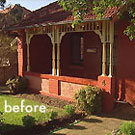This makeover is a classic example of how to extend adventurous colours from the house out into the garden. Don was driving along the street recently and noticed a house painted in fabulous colours. The owner had actually mixed the main brick-red colour himself, using Wattyl Solagard paint. He used one part ‘Terracotta’ to four parts ‘War Dance’, with a pink shade called ‘Outback Earth’ on the stucco wall. The timber lacework was painted cream.
Although the house look great, the garden needed some work. The garden bed in front of the verandah was bare, apart from two dwarf nandinas (Nandina domestica ‘Nana’). Federation daisies were planted on either side of the path leading to the front door. These are wonderful plants, but their mauve-pink flowers clashed with the colour scheme of the house. Don decided to remove the Federation daisies but keep the two nandinas, as the red in their leaves worked well with the brick-red colour on the house. The area was then made over using a new variety of nandina and some golden foliage plants to complement the stunning colours on the building.
Front garden bed
Don planted a new variety of dwarf nandina called ‘Gulf Stream’ (Nandina domestica ‘Gulf Stream’) in the middle of the bed. It grows into a rounded bun shape about 50cm (20″) high and 50cm (20″) wide. It is smaller than the species but slightly larger than the dwarf form, ‘Nana’. It has graceful, bamboo-like foliage, colouring to beautiful orange and scarlet tones in the cooler months of the year. It will grow in most areas of Australia, except for the tropics. Variegated flax (Phormium tenax ‘Variegatum’) was planted on either side of the new nandina. This hardy, clumping plant comes from New Zealand. It has striped, creamy yellow and white foliage, which added a little extra zing to the cream paint colour on the house. Flax will grow everywhere in Australia.
Hydrophobic soil
The front garden bed was situated under the eaves of the house, so it didn’t get any rain. The soil was not only dust dry, but it was also water repellent (or hydrophobic) and water just ran off instead of soaking into the soil. Don gave the garden bed a deep watering by pushing the nozzle of the hose down into the soil. The soil was then treated with Wettasoil (SaturAid or other wetting agents are also suitable) and the bed was watered again. Don recommended watering this garden bed every day for about a week to make sure the soil was really saturated, and also putting in an irrigation system.
Golden hedge
After carefully removing the Federation daisies and potting them up for use elsewhere in the garden, Don planted the sides of the front path with golden duranta (Duranta erecta ‘Sheena’s Gold’). This hardy, drought resistant plant has dense, yellow foliage and grows to around 3m (10′) tall. It responds well to pruning and can easily be maintained as a low hedge or grown as a tall screen.
Hedging tip
To work out the spacing between plants when putting in a hedge, divide the length of the bed by one more than the number of plants. So taking the example of the duranta hedge, the length of the bed was 3.6m and there were 5 plants: 3.6 divided by 6 = 600mm. Therefore the separation needed between each plant was 600mm. The makeover was completed by mulching the beds with red gum chips, which also picked up the orange-red colours of the house.
Further information
Wattyl Solagard paint costs around $58 for 4 litres. Nandina domestica ‘Gulf Stream’ ($20 for a 200mm or 8″ pot) and Duranta erecta ‘Sheena’s Gold’ ($16 for a 200mm or 8″ pot) are readily available at nurseries and garden centres. Variegated flax can be difficult to obtain. Expect to pay about $50 for 300mm (12″) pots. Wettasoil costs about $9 for 50ml, and SaturAid is priced at around $9 for 50g. A 50 litre bag of red gum chips costs around $7.



